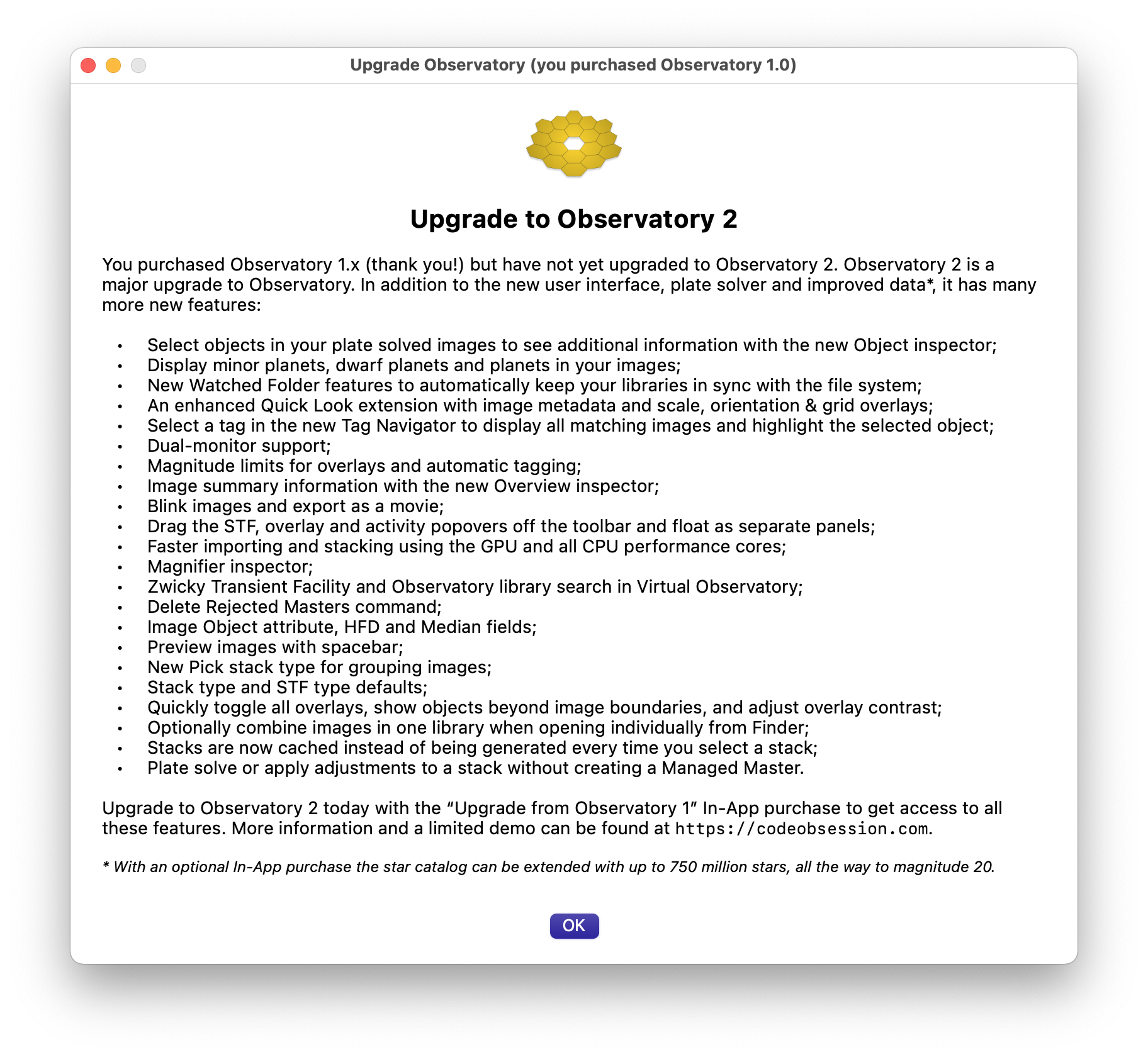
“I must admit … that I didn’t really understand the advantages that were on offer when I got the upgrade. I expected v2 to offer minor additional functionality plus maybe some bug fixes. … I wasn’t even aware … about the need to make a payment (well worth it by the way) to unlock the upgrade. At which point, the scope of the improvement in going from v1 to v2 became clear.”
It was recently brought to my attention that Observatory 1.x users may not realize the magnitude of the Observatory 2 upgrade. Although you undoubtedly noticed the user interface changes, many of you may not know that Observatory 2 is capable of doing way more than Observatory 1.x.
The Apple Mac App Store doesn’t have a good mechanism for major upgrades where existing users receive a discount, so how this is implemented for Observatory 2 is that users who previously purchased Observatory and have compatible hardware receive the new application as a regular update, but with the new features disabled. Although you received a lot of niceties like the new user interface, plate solver and merged star & deepsky catalogs for free this way, overall it still has mostly the same features as Observatory 1.x in this mode.
Obviously I didn’t communicate this well. It didn’t help that the upgrade information was only shown once, and that a few new features accidentally were enabled without actually upgrading to Observatory 2. Observatory 2.0.3, which has just been released to the Mac App Store fixes this.
As before, user interface elements for features that never existed in Observatory 1.x are disabled. For example limiting overlay magnitudes, quickly toggling all overlays and displaying overlays beyond image boundaries never was possible in Observatory 1.x.
What may not be apparent is that there are many more new features, because they are completely hidden from view unless you upgrade. My personal favorite is the 500,000 minor planets, and the fact that it works for images that were taken up to 23 years ago. With it I found minor planets in my old images of the 2000s that were only discovered a few years before I accidentally captured them. What’s also cool with this feature is that if you believe you captured an image of a minor planet but you don’t know its coordinates, you can just type the name of the minor planet in the plate solver and Observatory will calculate the position and use that as the initial estimate for the plate solver.
Another great new feature is the ability to select any object in an image and access additional information with the new Object Inspector. It will even include links to external resources, including SkySafari. And the new Tag Navigator, where you can select an object and Observatory will highlight the object in your image. Or the ability to have the STF and Overlay panels floating as separate windows and the canvas full screen on a second monitor. And of course, the ability to go as faint as magnitude 20 with the star catalog is simply amazing.
Observatory 2 is a huge upgrade, and there are many more new features than what is listed above. There is a reason why Observatory grew from a 150MB application to a 3GB application. If you didn’t upgrade from Observatory 1.x yet, read more about it and download the limited demo at https://codeobsession.com. The limited demo does not contain the minor planets, but it will give you a good idea of the other capabilities.
Observatory 2.0.3 adds the Object attribute, initialized with the value of the corresponding FITS keyword. You can edit it, and it can be shown in the icon browser subtitle, the list browser and used in smart albums. For existing libraries, close and reopen the library to see the new column. For older libraries, you can instruct Observatory to initialize it by selecting the image(s), choosing Image ▸ Reset… and in there select Metadata Merge and enable Sync Master.
This update also fixes a large GPU memory leak that was not apparent in our tests before. And an issue where selecting images in the browser would sometimes result in extreme CPU usage.
It actually has a ton of little improvements throughout, and you can read about those in its release notes.